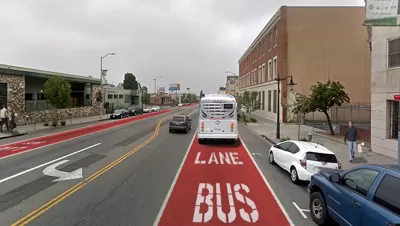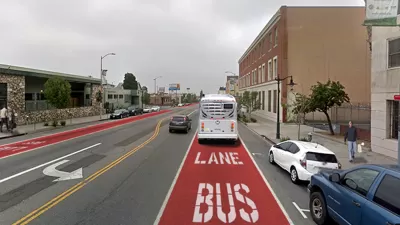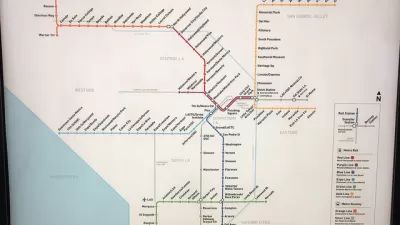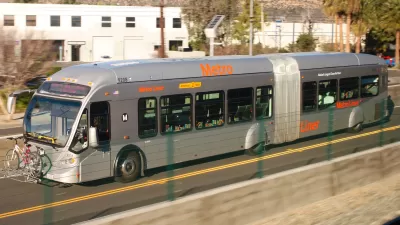Anyone hoping for rail transit down one of Los Angeles' busiest transit corridors will have to wait awhile.

When Los Angeles voters approved Measure M in 2016, they provided some funding for a planned bus rapid transit (BRT) route down 12.4 miles of the very busy Vermont Avenue corridor. That project is scheduled to begin in 2024 and open by 2028, if complete funding construction is acquired before then.
Now, however, the Los Angeles County Metropolitan Transportation Authority (Metro) is making plans to turn that BRT project into a light rail route in the very distant future.
"A report to be given this week to the Metro Board's Planning and Programming sheds light on how an as-of-yet unbuilt bus rapid transit line on Vermont Avenue could be converted into a rail line in the distant year of 2067," reports Steven Sharp.
The report studies rail transit as an option and comes up with three options, explains Sharp:
- Center-running light rail transit - similar to the Blue Line - with below-grade between operations between Wilshire/Vermont Station in Koreatown and Gage Avenue, where trains would proceed to an at-grade alignment within a wide center median to 120th Street;
- An extension of the Red Line starting at the corner of Vermont and 3rd Street, continuing south in a fully below-grade alignment to 120th Street; and
- A standalone heavy rail line starting at Wilshire/Vermont Station and proceeding below-grade to 120th Street.
In current construction costs, these projects would require between $4.4 billion on the cheap end and $8.4 billion on the expensive end. In 2067 costs, that would be $21.1 billion and $34.7 billion.
The largest impediment to any new transit on Vermont Avenue is funding, according to Sharp. Even the BRT project only has $25 million in funding from the Measure M total.
For insight into the importance of Vermont Avenue in the Los Angeles regional transit system, see an opinion written by Alon Levy in early 2018.
FULL STORY: Study Explores How Metro Could Convert the Proposed Vermont BRT Line to Rail

Planetizen Federal Action Tracker
A weekly monitor of how Trump’s orders and actions are impacting planners and planning in America.

San Francisco's School District Spent $105M To Build Affordable Housing for Teachers — And That's Just the Beginning
SFUSD joins a growing list of school districts using their land holdings to address housing affordability challenges faced by their own employees.

The Tiny, Adorable $7,000 Car Turning Japan Onto EVs
The single seat Mibot charges from a regular plug as quickly as an iPad, and is about half the price of an average EV.

Seattle's Plan for Adopting Driverless Cars
Equity, safety, accessibility and affordability are front of mind as the city prepares for robotaxis and other autonomous vehicles.

As Trump Phases Out FEMA, Is It Time to Flee the Floodplains?
With less federal funding available for disaster relief efforts, the need to relocate at-risk communities is more urgent than ever.

With Protected Lanes, 460% More People Commute by Bike
For those needing more ammo, more data proving what we already knew is here.
Urban Design for Planners 1: Software Tools
This six-course series explores essential urban design concepts using open source software and equips planners with the tools they need to participate fully in the urban design process.
Planning for Universal Design
Learn the tools for implementing Universal Design in planning regulations.
Smith Gee Studio
City of Charlotte
City of Camden Redevelopment Agency
City of Astoria
Transportation Research & Education Center (TREC) at Portland State University
US High Speed Rail Association
City of Camden Redevelopment Agency
Municipality of Princeton (NJ)





























